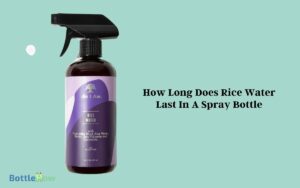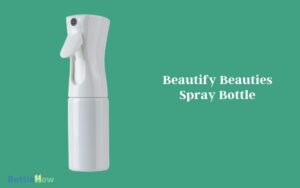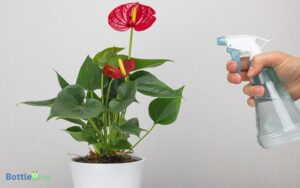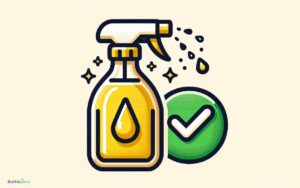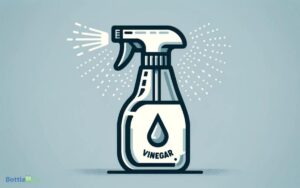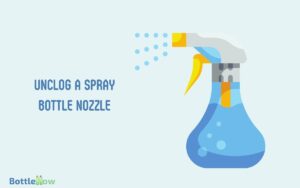How to Mix Lysol Concentrate Disinfectant in Spray Bottle?
To mix Lysol Concentrate Disinfectant in a spray bottle, first put on protective gloves for safety. Use a clean measuring cup and funnel to guarantee accurate and mess-free dilution.
Check the product label for the recommended dilution ratio, typically found under ‘Calculating and Mixing Ratios’. Pour the specified amount of concentrate into your spray bottle, then add water up to the required level.
Shake gently to blend the solution thoroughly. Properly label your bottle to prevent misuse. Always store the mixed disinfectant in a cool, dry place and use within a week for best results. Explore further to optimize your cleaning technique and ensure safety.
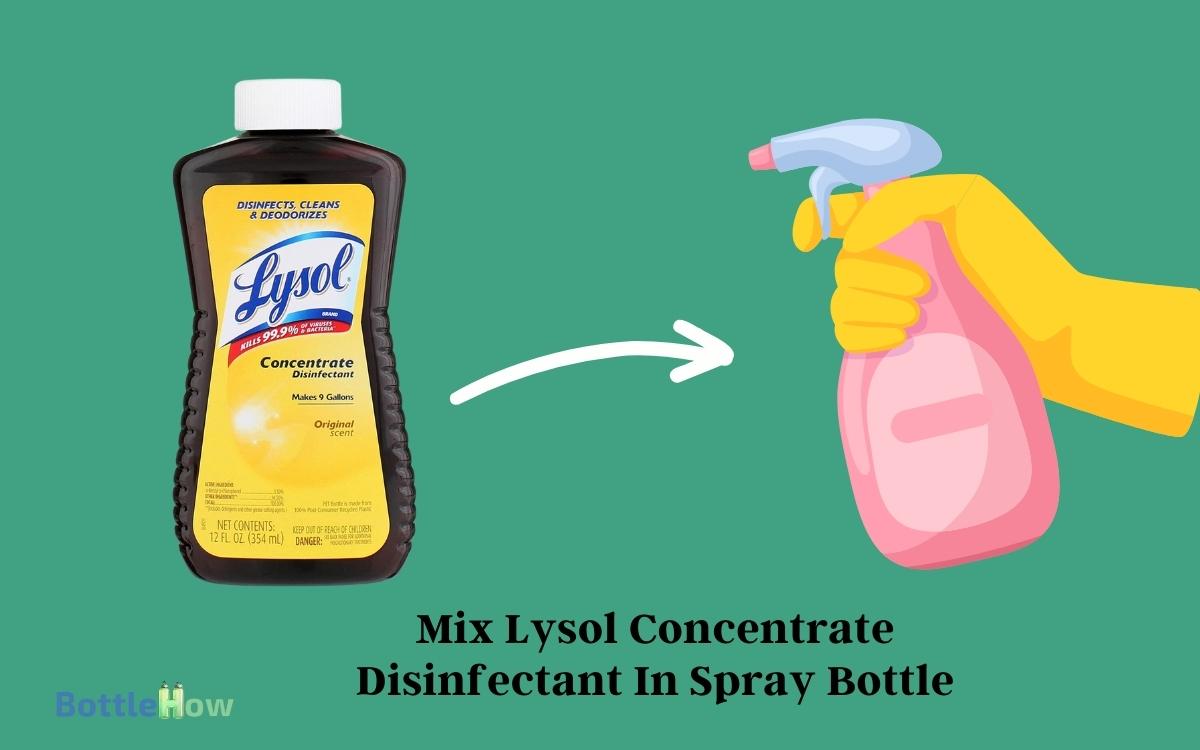
Key Takeaways
Gather Your Materials
Before you begin mixing Lysol Concentrate Disinfectant, it’s important to gather all the necessary materials to guarantee a safe and efficient process.
You’ll need protective gloves to safeguard your hands from chemicals. Also, make sure you have a clean measuring cup to accurately measure the disinfectant, preventing any guesswork that could compromise the effectiveness of your solution.
A funnel will be handy to transfer the mixture without spills, maintaining a clean and safe workspace. Finally, prepare a label and a permanent marker to clearly mark your mixed solution, avoiding any potential misuse.
Each of these items plays a pivotal role in ensuring that you can serve others in a safe, effective, and responsible manner.
Choose the Right Bottle
Selecting the appropriate bottle for your Lysol solution guarantees safety and preserves the efficacy of the disinfectant. You’ll want a bottle that’s sturdy and chemical-resistant. Opt for a high-quality spray bottle specifically designed to handle cleaning chemicals.
These bottles are typically made from materials such as HDPE (high-density polyethylene) or PET (polyethylene terephthalate), which don’t degrade or react with the ingredients in Lysol.
Ensure the bottle is clean and hasn’t been used for other chemicals, as residue could cause harmful reactions or diminish the effectiveness of the Lysol. Choosing the right bottle helps you serve others by maintaining a high standard of hygiene and safety in environments you care for.
Always prioritize durability and compatibility with cleaning agents.
Read the Label Carefully
Always read the label on your Lysol Concentrate Disinfectant carefully to guarantee proper usage and safety.
The label contains crucial information, including precautionary statements and first aid measures. It’s imperative you understand these details to protect yourself and others when handling chemicals.
Look for any specific warnings about the surfaces on which it can be safely used, and pay close attention to any health advisories. This isn’t just about maintaining cleanliness—it’s about ensuring everyone’s safety.
If you’re ever unsure or have questions, don’t hesitate to reach out to the manufacturer’s customer service for clarity. Remember, you’re not just cleaning; you’re caring for the health and well-being of all who enter your space.
Calculate the Correct Ratio
To guarantee the effectiveness of Lysol Concentrate Disinfectant, you’ll need to calculate the correct dilution ratio.
- Start by understanding the necessary proportions as specified on the product label.
- Measure the ingredients accurately to maintain the disinfectant’s efficacy and safety.
Understanding Dilution Ratios
You’ll need to calculate the accurate dilution ratio to guarantee the Lysol Concentrate Disinfectant is effective without being wastefully strong.
This ratio is vital because it ensures that the disinfectant maintains its ability to kill germs while being safe for use on surfaces and around your family or clients. Each type of cleaning task might require a slightly different concentration.
For general disinfecting, a common recommendation is to use a more diluted solution, which balances efficacy and safety. However, for areas that are more prone to bacteria and viruses, a stronger mix might be necessary.
Always adhere to the guidelines provided by the manufacturer to decide the best ratio for your specific needs, ensuring you serve others in the safest, most efficient way.
Measuring Ingredients Accurately
Ensuring you measure the Lysol Concentrate Disinfectant accurately, based on the recommended dilution ratio, is essential for effective and safe disinfection.
Here’s a quick guide to help you get the proportions just right:
| Purpose | Lysol Concentrate (ml) | Water (ml) |
|---|---|---|
| General Cleaning | 50 | 950 |
| Heavy Disinfection | 125 | 875 |
| Floor Mopping | 100 | 900 |
| Bathroom Disinfection | 150 | 850 |
| Garbage Area | 200 | 800 |
Always use a precise measuring device to ensure accuracy. It’s essential to mix the solution properly to maintain its effectiveness while ensuring it is safe to use, particularly in spaces that require stringent hygiene.
Mix Water and Concentrate
Begin by carefully measuring the concentrate, then add it to the water, stirring thoroughly to guarantee proper dilution. It’s important to make sure the mixture is uniform to maximize the effectiveness of the disinfectant.
Here’s how to proceed:
- Use the Right Ratio: Follow the recommended ratio from the Lysol label to maintain efficacy and safety.
- Stir Gently: Use a clean stirrer to mix, avoiding vigorous shaking which can create unwanted bubbles.
- Check Consistency: The solution should be clear without any undissolved particles. If particles remain, continue stirring until fully dissolved.
- Test pH: Optionally, you can use pH strips to check the acidity, ensuring it’s within a safe range for use.
This careful approach helps ensure you’re creating a safe and effective disinfectant solution.
Secure the Spray Nozzle
Once you’ve mixed your solution, it’s essential to select the appropriate spray nozzle for effective application.
Make sure you attach the nozzle securely to prevent leaks and ensure a consistent spray pattern.
Before proceeding, always test the nozzle’s functionality to avoid any mishaps during the disinfection process.
Choosing the Right Nozzle
Securing the appropriate spray nozzle is crucial for effective and safe application of the Lysol Concentrate Disinfectant. Choosing the right nozzle involves understanding its features and ensuring compatibility with your spray bottle.
Here are key factors to take into account:
- Material Durability: Opt for nozzles made from chemical-resistant materials to prevent deterioration.
- Spray Pattern: Select a nozzle that offers adjustable settings to control the spray pattern suitable for different surfaces.
- Flow Rate: Choose a nozzle that allows for easy adjustment of the disinfectant flow, facilitating efficient coverage without wastage.
- Compatibility: Guarantee the nozzle fits securely to your bottle, preventing leaks and ensuring precise application.
Attaching Nozzle Correctly
After selecting the right nozzle, you’ll need to attach it properly to guarantee peak performance and safety. Start by aligning the nozzle with the top of the spray bottle. Make sure it’s facing the right direction; this prevents any potential leaks or spray malfunctions.
Carefully twist the nozzle clockwise onto the bottle’s neck until it’s snug. Don’t over-tighten, as this might damage the threads or the nozzle itself, leading to possible leaks. If you notice any resistance while twisting, pause and realign the nozzle to avoid cross-threading. Once secured, test the spray function to ensure a proper seal and smooth operation. If the spray becomes blocked, refer to instructions on how to unclog spray bottle mechanisms to restore proper flow.
It’s essential to make sure the nozzle is securely fastened so that when you use the spray, it functions efficiently, directing the disinfectant exactly where you need it.
This attention to detail ensures you’re serving those around you effectively, maintaining a clean and safe environment for everyone.
Testing Nozzle Functionality
Have you securely attached the nozzle? Now test its functionality by giving the spray bottle a few test sprays into the sink. It’s important to make sure that the disinfectant is dispensed correctly to maintain a safe and effective cleaning environment.
Here’s what you’ll need to check:
- Spray Pattern: Verify the spray is even and consistent. If it sputters or leaks, you’ll need to recheck the nozzle’s attachment.
- Seal Integrity: Look for any leaks where the nozzle connects to the bottle. Any leakage could compromise the disinfectant strength.
- Ease of Use: Confirm that the trigger is easy to press and doesn’t stick.
- Lock Function: Test the nozzle’s lock feature to prevent accidental discharge when not in use.
Test the Solution
Before using the mixed solution extensively, it’s crucial to test its efficacy on a small, inconspicuous area. This step guarantees that the solution won’t damage or discolor the surfaces you’re aiming to disinfect.
Apply a small amount of the diluted Lysol to an area that’s typically out of sight, such as behind an appliance or under a piece of furniture. Let it sit for a few minutes, then check for any adverse reactions.
If you don’t observe any damage or discoloration, you’re likely safe to proceed with broader application.
However, if there are negative effects, you may need to adjust the dilution ratio or reconsider the suitability of this solution for certain surfaces, prioritizing safety and effectiveness in your cleaning practices.
Label the Bottle
Once you’ve mixed your Lysol Concentrate Disinfectant, it’s important that you label the bottle accurately.
You’ll need to select a label size that fits your container and guarantees all instructions are easily readable. Remember to write clear, concise instructions on how to use the solution safely and effectively.
Choose Appropriate Label Size
Choosing the appropriate label size for your Lysol concentrate bottle guarantees all essential information is clear and accessible.
When preparing to label your disinfectant mixture, consider the following:
- Bottle Size: Match the label size to the bottle. A label too large can overlap and obscure information.
- Visibility: Confirm the label is large enough to read from a reasonable distance. This aids in quick identification.
- Legibility: Select a label size that allows space for all necessary details without crowding. This prevents misinterpretation.
- Aesthetics: Opt for a size that looks balanced on the bottle, contributing to a professional appearance.
Write Clear Instructions
After selecting the right label size, it’s important to write clear, accurate instructions on how to mix and use the Lysol concentrate.
Start by specifying the ratio of concentrate to water. For example,
- You’d write, “Mix 1 part concentrate with 5 parts water.”
- It’s vital to include safety information, such as, “Use gloves and avoid contact with eyes.”
Next, describe the application method:
- “Spray onto surfaces and leave for 10 minutes before wiping.”
- Also, remind users to store the bottle in a cool, dry place away from children and pets.
Store Safely
Make sure you store your Lysol Concentrate Disinfectant in a cool, dry place away from direct sunlight and out of reach of children and pets. Storing cleaning products safely is critical, especially when you’re responsible for the well-being of others.
Here’s a concise list to guarantee proper storage:
- Label the Bottle: Clearly mark your spray bottles with the contents and date of mixing.
- Keep It Upright: Store the bottle in an upright position to prevent leaks and chemical degradation.
- Secure the Cap: Always tighten the cap to avoid evaporation and unintended spills.
- Check Regularly: Inspect the storage area periodically for any signs of damage or leaks to avoid accidents.
Following these steps helps ensure the safety and efficacy of your disinfectant.
Tips for Effective Use
To guarantee your Lysol Concentrate Disinfectant works effectively, follow these application guidelines closely.
- Always wear gloves to protect your hands and make sure the area is well-ventilated before you start.
- You’ll want to apply the mixed solution directly to the surface, ensuring it’s thoroughly covered.
- Allow it to sit for the recommended time on the label to achieve maximum germ-killing efficiency.
- It’s best to avoid mixing the concentrate with other cleaning products, as this can reduce its effectiveness or even create harmful reactions.
- Remember, precise measurements are vital; too much can be wasteful and potentially damaging, while too little may not sufficiently disinfect.
Your diligence ensures a safer environment for everyone relying on these spaces.
Cleaning and Maintenance
Frequently cleaning your workspace with Lysol Concentrate Disinfectant guarantees it remains hygienic and prolongs the lifespan of surfaces.
To maintain your environment effectively, consider the following steps:
- Dilute Properly: Always follow the manufacturer’s instructions for dilution ratios to ensure effectiveness without damaging surfaces.
- Regular Schedule: Set a cleaning schedule and stick to it. Daily disinfection of high-touch areas is vital.
- Use Suitable Tools: Employ microfiber cloths or sponges specifically designated for disinfectant use to avoid cross-contamination.
- Proper Storage: Store your diluted solution in a cool, dark place and replace it every week to maintain its potency.
Conclusion
Now that you’ve mastered the art of mixing your Lysol concentrate, think of your spray bottle as a trusty sword in your cleaning arsenal.
Use it wisely to vanquish germs and bring a sparkle to your kingdom.
Remember, precision in preparation leads to victory in sanitation.
Store your concoction safely out of reach of curious hands, and maintain your tools diligently.
With these practices, you’ll keep your castle clean and your court healthy.

